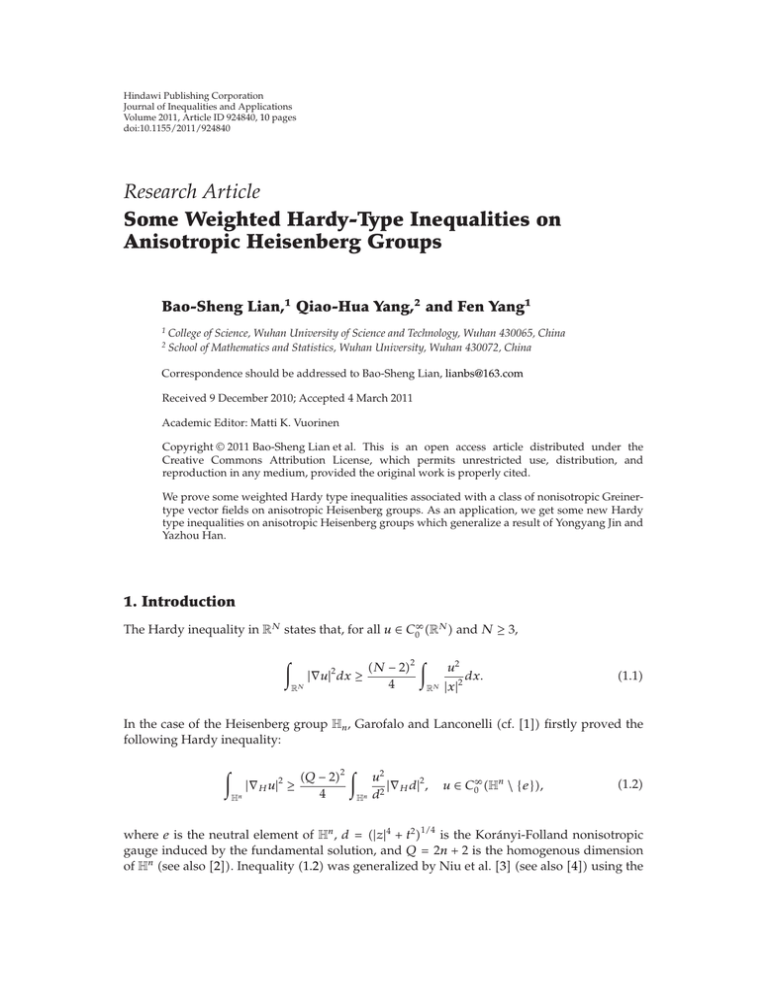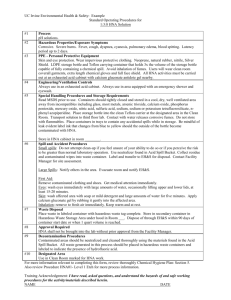Document 10943886
advertisement

Hindawi Publishing Corporation
Journal of Inequalities and Applications
Volume 2011, Article ID 924840, 10 pages
doi:10.1155/2011/924840
Research Article
Some Weighted Hardy-Type Inequalities on
Anisotropic Heisenberg Groups
Bao-Sheng Lian,1 Qiao-Hua Yang,2 and Fen Yang1
1
2
College of Science, Wuhan University of Science and Technology, Wuhan 430065, China
School of Mathematics and Statistics, Wuhan University, Wuhan 430072, China
Correspondence should be addressed to Bao-Sheng Lian, lianbs@163.com
Received 9 December 2010; Accepted 4 March 2011
Academic Editor: Matti K. Vuorinen
Copyright q 2011 Bao-Sheng Lian et al. This is an open access article distributed under the
Creative Commons Attribution License, which permits unrestricted use, distribution, and
reproduction in any medium, provided the original work is properly cited.
We prove some weighted Hardy type inequalities associated with a class of nonisotropic Greinertype vector fields on anisotropic Heisenberg groups. As an application, we get some new Hardy
type inequalities on anisotropic Heisenberg groups which generalize a result of Yongyang Jin and
Yazhou Han.
1. Introduction
The Hardy inequality in RN states that, for all u ∈ C0∞ RN and N ≥ 3,
RN
|∇u|2 dx ≥
N − 22
4
RN
u2
|x|2
dx.
1.1
In the case of the Heisenberg group Hn , Garofalo and Lanconelli cf. 1 firstly proved the
following Hardy inequality:
Q − 22
|∇H u| ≥
4
Hn
2
Hn
u2
|∇H d|2 ,
d2
u ∈ C0∞ Hn \ {e},
1.2
where e is the neutral element of Hn , d |z|4 t2 1/4 is the Korányi-Folland nonisotropic
gauge induced by the fundamental solution, and Q 2n 2 is the homogenous dimension
of Hn see also 2. Inequality 1.2 was generalized by Niu et al. 3 see also 4 using the
2
Journal of Inequalities and Applications
Picone-type identify. For more Hardy-Sobolev inequalities on nilpotent groups, we refer the
reader to 5–19.
More recently, Jin and Han cf. 20, 21, using the method by Niu et al. 3, have
proved the following Hardy inequalities on anisotropic Heisenberg groups Hna :
Hna
|∇L u|p ≥
p n
2 j1 aj 2 − p
p
n
j1
2 p/2 n
2 k−1p
zj a2j zj a
j
j1
Nz, t2kp
Hna
|u|p ,
1.3
where ∇L are the nonisotropic Greiner-type vector fields, k is a positive integer,
⎛
Nz, t4k ⎝
n
⎞2k
2
aj zj ⎠ t2 ,
1.4
j1
and 2 ≤ p < 2 nj1 aj 2. However, the inequalities above do not cover the case of 1 < p < 2
n
and 2 j1 aj 2k ≤ p < 2n 2k. So, it is an interesting problem to study a Hardy-type
inequality related to Nz, t for 1 < p < 2 on Hna and 2 nj1 aj 2k ≤ p < 2n 2k. In this
note, we will consider some Hardy inequalities on Hna for 1 < p < 2n 2k. In fact, we prove
a representation formula associated with Nz, t, which is analogous to the Korányi-Folland
nonisotropic gauge on Heisenberg group cf. 22. Using this representation formula, we
prove some new Hardy inequalities on Hna , which include the case of 1 < p < 2 and 2 nj1 aj 2k ≤ p < 2n 2k.
This paper is organized as follows. We start in Section 2 with the necessary background
on anisotropic Heisenberg groups Hna . In Section 3, we prove a representation formula and use
it to obtain some Hardy-type inequalities.
2. Notations and Preliminaries
Recall that the anisotropic Heisenberg groups Hna are the Carnot group of step two whose
group structure is given by cf. 23
⎞
n
z, t ◦ z , t ⎝z z , t t 2 aj zz ⎠,
⎛
2.1
j1
where z z1 , . . . , zn , zj xj iyj xj , yj ∈ R, and a1 , . . . , an are positive constants,
numbered so that
0 < a1 ≤ a2 ≤ · · · ≤ an .
2.2
Journal of Inequalities and Applications
3
We consider the following nonisotropic Greiner-type vector fields which are introduced by
Jin and Han 21:
⎛
⎞k−1
n
2
∂
∂
,
2kaj yj ⎝ aj zj ⎠
Xj ∂xj
∂t
j1
⎛
⎞k−1
n
2
∂
∂
Yj ,
− 2kaj xj ⎝ aj zj ⎠
∂yj
∂t
j1
2.3
j 1, . . . , n. These vector fields are not left or right invariant when k ≥ 2. The horizontal
gradient is the 2n- dimensional vector given by
∇L X1 , . . . , Xn , Y1 , . . . , Yn .
2.4
A natural family of anisotropic dilations related to ∇L is
δλ z, t λz, λ2k t .
2.5
For simplicity, we denote by λz, t λz, λ2k t. The Jacobian determinant of δλ is λQ , where
Q 2n 2k is the homogenous dimension. The anisotropic norm on Hna is
⎞1/4k
⎛⎛
⎞2k
n
2
⎟
⎜
.
Nz, t ⎝⎝ aj zj ⎠ t2 ⎠
2.6
j1
For simplicity, we use the notation |z|2 n
j1
|zj |2 and |z|2a n
j1
aj |zj |2 . Then,
1/4k
2
,
Nz, t |z|4k
a t
2.7
and a1 |z|2 ≤ |z|2a ≤ an |z|2 . With this norm, we can define the metric ball centered at neutral
element and with radius ρ by
B e, ρ z, t ∈ Hna : Nz, t < ρ ,
2.8
and the unit sphere Σ ∂Be, 1. Furthermore, we have the following polar coordinates for
all f ∈ L1 Hna cf. 24:
Hna
fz, tdz dt ∞ 0
Σ
frz∗ , t∗ r Q−1 dσ dr,
2.9
where z∗ z/Nz, t and t∗ t/N 2k z, t.
β
Let β > −2n and set Cβ Σ |z∗ |a dσ. We will explicitly calculate the constant Cβ to show
Cβ < ∞ when β > −2n. The method of calculation is similar to that used in 22.
4
Journal of Inequalities and Applications
Lemma 2.1. For β > −2n,
ω2n−1 Γ1/2Γ β Q − 2k /4k
,
Cβ n
Γ β Q /4k
j1 aj
2.10
where ω2n−1 is the volume of S2n−1 , that is, the unit sphere in R2n .
Proof. To compute Cβ , let β > −Q, then,
Σ
β
|z∗ |a dσ Q β
Qβ
Qβ
1
r βQ−1 dr
1
Σ
0
β
Σ
0
|z∗ |a dσ
β
|rz∗ |a r Q−1 dr dσ
2.11
β
Nz,t<1
|z|a dσ.
Next, if β > −2n,
Nz,t<1
β
|z|a dσ |t|<1
β
|z|a <1−|t|2 1
n
j1 aj
|z|a dz dt
1/4k
2 1/4k
|t|<1
|z|<1−|t| |z|β dz dt.
2.12
Therefore,
Nz,t<1
β
|z|a dσ
ω2n−1
n
j1 aj
1−|t|2 1/4k
|t|<1
r β2n−1 dr dt
0
ω2n−1
n
2n β
j1 aj
ω2n−1
n
2n β
j1 aj
|t|<1
1
1 − |t|2
β2n/4k
dt
1 − sβ2n/4k s−1/2 ds
0
β 2n
1
ω2n−1
1,
B
n
4k
2
2n β
j1 aj
Γ β 2n /4k 1 Γ1/2
ω2n−1
.
·
n
Γ β Q /4k 1
2n β
j1 aj
2.13
Journal of Inequalities and Applications
5
Thus, if β > −2n,
Cβ Q β
β
Nz,t<1
|z|a dσ
ω2n−1 Γ1/2Γ β 2n /4k
n
Γ β Q /4k
j1 aj
2.14
ω2n−1 Γ1/2Γ β Q − 2k /4k
.
n
Γ β Q /4k
j1 aj
3. Hardy-Type Inequality
Firstly, we prove the following representation formula on Hna , which is of its independent
interest.
Lemma 3.1. Let β > −2n 2k − 1 and f ∈ C0∞ Hna . Then,
−Cβ f0 1
4k
β2−4k
|z|a
Hna
Nz, tQβ
∇L fz, t, Λa ∇L Nz, t4k dz dt,
3.1
where Λa is a diagonal matrix given by
Λa diag
1 1
1
1
,..., , ,...,
.
a1
an a1
an
3.2
Proof. We argue as in the proof of Theorem 1.2 in 22. Since f ∈ C0∞ Hna ,
∞
d
frz∗ , t∗ dr
dr
0
∞ n
yj ∂f
xj ∂f
2kt ∂f
∗ ∗
∗ ∗
rz , t rz , t rz∗ , t∗ dr
r ∂xj
r ∂yj
r ∂t
0 j1
−f0 ∞ n
0
j1
∞ n
0
j1
yj ∂f
xj ∂f
z, t z, t
r ∂xj
r ∂yj
2kt ∂f
z, tdr
r ∂t
aj xj2 aj yj2 2k|z|2k−2 t ∂f
yj ∂f
xj ∂f
a
·
z, t z, t z, t dr.
r ∂xj
r ∂yj
r
∂t
|z|2k
a
3.3
6
Journal of Inequalities and Applications
Therefore,
−Cβ f0 −
Σ
Hna
Hna
β−2k n |z|a 2k
2k
X
f
·
x
y
t
Y
f
·
y
−
x
t
|z|
|z|
j
j
j
j
j
j
a
a
N Qβ j1
f0
β
n
xj2 yj2
∂f
∂f
|z|a 2k−2 ∂f
yj
aj
· 2k|z|a t
xj
dz dt
∂xj
∂yj
∂t
N Qβ j1
|z|2k
a
β
|z∗ |a dσ
β−2k n
∂f
∂f
t|z|a yj
dz dt.
− xj
∂xj
∂yj
N Qβ j1
−
3.4
Hna
Notice that
Xj N 4k 4kaj |z|2k−2
|z|2k
a
a xj yj t ,
Yj N 4k 4kaj |z|2k−2
|z|2k
a
a yj − xj t ,
3.5
we have, by 3.4,
−Cβ f0 1
4k
β2−4k
|z|a
Hna
−
Nz, tQβ
Hna
∇L fz, t, Λa ∇L Nz, t4k dz dt
β−2k n
∂f
∂f
t|z|a yj
dz dt.
− xj
∂xj
∂yj
N Qβ j1
To finish the proof, it is enough to show that
β−2k n
∂f
∂f
t|z|a yj
dz dt
− xj
Qβ
∂xj
∂yj
Hna N
j1
3.6
3.7
vanishes. Notice that the operator yj ∂xj − xj ∂yj annihilates functions of |z|a , and, for β > −2n
2k −1, the integrand above is absolutely integrable. We have, for any > 0, though integration
by parts,
Hna
β/2−2 n
t |z|2a ∂f
∂f
yj
dz dt 0.
− xj
Qβ/4
4
∂xj
∂yj
N j1
3.8
Let → 0. By dominated convergence theorem,
Hna
β−2k n
∂f
∂f
t|z|a yj
dz dt 0.
− xj
∂xj
∂yj
N Qβ j1
The proof is therefore completed.
3.9
Journal of Inequalities and Applications
7
We now prove the following Hardy inequalities on Hna .
Theorem 3.2. Let 1 < p < Q − α and γ > −2n − p − 12k − 1. There holds, for all u ∈ C0∞ Hna ,
γ
Hna
|∇L u|p |z|a
Nα Nγ
|z|
|z|a
p
≥
Q−p−α
p
p γp2k−1
Hna
|u|p |z|a
.
N αp N γp2k−1
3.10
Proof. Set u : |u|2 2 p/2 −p with > 0. Replacing f by u N Q−p−α in Lemma 3.1, we obtain,
for any β > −2n 2k − 1,
1
0
4k
β2−4k
|z|a
Nz, tQβ
Hna
1
4k
Hna
∇L u , Λa ∇L N 4k N Q−p−α
β2−4k |z|a
Q−p−α
4k
∇
u .
N
,
Λ
∇
N
L
a
L
Qβ
3.11
Nz, t
It is easy to check that the following equations hold
n
2 2 2k
2k
a
x
y
t
|z|
y
−
x
t
|z|
∇L N 4k , Λa ∇L N 4k 16k2 |z|4k−4
j
j
j
a j
a j
a
j1
N 4k ;
16k2 |z|4k−2
a
n 2 2 2k
2k
Λa ∇L N 4 , Λa ∇L N 4 16k2 |z|4k−4
x
y
t
|z|
y
−
x
t
|z|
j
j
a j
a j
a
j1
16N 4k |z|4k−4
|z|2 .
a
Therefore, by 3.11,
1
4k
β2−4k
|z|a
∇L N Q−p−α , Λa ∇L N 4k u
Nz, tQβ
β2−4k ∇L N 4k , Λa ∇L N 4k
Q−p−α
|z|a
u
16k2
Nz, tpαβ−4k
Hna
Hna
Q−p−α
β
|z|a
Hna
Nz, tpαβ
u
3.12
8
Journal of Inequalities and Applications
1
−
4k
−
≤
p
4k
≤
p
4k
Nz, t
Hna
p
4k
β−2
|z|a
Nz, t
Hna
β2−4k
Hna
β2−4k
|z|a
p−2/2
|u| · |∇L u| · Λa ∇L N 4k p−1/2
|∇L u| · Λa ∇L N 4k |u|2 2
Nz, tpαβ
β−2k
|z|a
|u|2 2
|z|
Nz, tpαβ−2k
Hna
p−2/2 u ∇L u, Λa ∇L N 4
Nz, tpαβ
Hna
|u|2 2
pαβ
|z|a
p
4k
∇
N Q−p−α
u
,
Λ
∇
N
L
a
L
Qβ
β2−4k
|z|a
|u|2 2
p−1/2
|∇L u|.
3.13
By dominated convergence, letting → 0, we have
Q−p−α
β
|z|a
Nz, t
Hna
|u|p ≤ p
pαβ
β−2k
|z|a
Hna
Nz, t
|z|
pαβ−2k
3.14
|u|p−1 |∇L u| .
By Hölder’s inequality,
Q−p−α
β
|z|a
Hna
Nz, tpαβ
≤p
|u|p
p−1/p β
|z|a
Hna
Nz, tpαβ
|u|p
β−p2k−1 Hna
|∇L u|p |z|a
N α N β−p2k−1
|z|
|z|a
3.15
p 1/p
.
Canceling and raising both sides to the power p, we obtain
Q−p−α
p
p β
|z|a
Hna
Nz, t
|u|p ≤
pαβ
β−p2k−1 Hna
|∇L u|p |z|a
N α N β−p2k−1
|z|
|z|a
p
.
3.16
Set γ β − p2k − 1. Then, γ > −2n − p − 12k − 1, and we get 3.11.
Remark 3.3. Notice that a1 |z|2 ≤ |z|2a ≤ an |z|2 , we have, by Theorem 3.2, for all u ∈ C0∞ Hna ,
γ
Hna
|∇L u|p |z|a
≥
Nα Nγ
√ p γp2k−1
a1 Q − p − α
|u|p |z|a
.
αp
p
N γp2k−1
Hna N
3.17
From inequality 3.17, we have the following corollary which generalizes the result
of 21 when 1 < p < 2 and 2 nj1 aj 2 − α ≤ p < Q − α.
Journal of Inequalities and Applications
9
Corollary 3.4. Let 0 < a1 ≤ a2 ≤ · · · ≤ an ≤ 1, 1 < p < Q − α and γ p ≥ 0. There holds, for all
u ∈ C0∞ Hna ,
Hna
|∇L u|
Nα
p
γ
|z|a
Nγ
γp/2
2pk−1 n
√ p 2 2
p |z|a
a
j1 j zj
a1 Q − p − α
|u|
≥
.
αp
p
N γp2k−1
Hna N
3.18
Proof. Since a1 ≤ a2 ≤ · · · ≤ an ≤ 1,
|z|2a n
n
2 2
aj zj ≥
a2j zj .
j1
3.19
j1
We have, by inequality 3.17,
Hna
|∇L u|
Nα
p
γ
|z|a
Nγ
γp/2
2pk−1 n
√ p 2 2
p |z|a
zj
a
j1
a1 Q − p − α
j
|u|
≥
.
αp
γp2k−1
p
N
Hna N
3.20
Acknowledgments
This paper was supported by the Fundamental Research Funds for the Central Universities
under Grant no. 1082001 and the National Natural Science Foundation of China Grant no.
10901126.
References
1 N. Garofalo and E. Lanconelli, “Frequency functions on the Heisenberg group, the uncertainty
principle and unique continuation,” Annales de l’Institut Fourier (Grenoble), vol. 40, no. 2, pp. 313–356,
1990.
2 J. A. Goldstein and Q. S. Zhang, “On a degenerate heat equation with a singular potential,” Journal of
Functional Analysis, vol. 186, no. 2, pp. 342–359, 2001.
3 P. Niu, H. Zhang, and Y. Wang, “Hardy type and Rellich type inequalities on the Heisenberg group,”
Proceedings of the American Mathematical Society, vol. 129, no. 12, pp. 3623–3630, 2001.
4 L. D’Ambrozio, “Some Hardy inequalities on the Heisenberg group,” Differential Equations, vol. 40,
no. 4, pp. 552–564, 2004.
5 J. Dou, “Picone inequalities for p-sub-Laplacian on the Heisenberg group and its applications,”
Communications in Contemporary Mathematics, vol. 12, no. 2, pp. 295–307, 2010.
6 J. A. Goldstein and I. Kombe, “The Hardy inequality and nonlinear parabolic equations on Carnot
groups,” Nonlinear Analysis: Theory, Methods & Applications, vol. 69, no. 12, pp. 4643–4653, 2008.
7 J. Han, “A class of improved Sobolev-Hardy inequality on Heisenberg groups,” Southeast Asian
Bulletin of Mathematics, vol. 32, no. 3, pp. 437–444, 2008.
8 J. Q. Han, P. C. Niu, and Y. Z. Han, “Some Hardy-type inequalities on groups of Heisenberg type,”
Journal of Systems Science and Mathematical Sciences, vol. 25, no. 5, pp. 588–598, 2005.
9 Y. Han, P. Niu, and X. Luo, “A Hardy type inequality and indefinite eigenvalue problems on the
homogeneous group,” Journal of Partial Differential Equations, vol. 15, no. 4, pp. 28–38, 2002.
10 J. Han, P. Niu, and W. Qin, “Hardy inequalities in half spaces of the Heisenberg group,” Bulletin of the
Korean Mathematical Society, vol. 45, no. 3, pp. 405–417, 2008.
11 Y. Jin and G. Zhang, “Degenerate p-Laplacian operators on H-type groups and applications to Hardy
type inequalities,” to appear in Canadian Journal of Mathematics.
10
Journal of Inequalities and Applications
12 J.-W. Luan and Q.-H. Yang, “A Hardy type inequality in the half-space on Rn and Heisenberg group,”
Journal of Mathematical Analysis and Applications, vol. 347, no. 2, pp. 645–651, 2008.
13 I. Kombe, “Sharp weighted Rellich and uncertainty principle inequalities on Carnot groups,”
Communications in Applied Analysis, vol. 14, no. 2, pp. 251–271, 2010.
14 W.-C. Wang and Q.-H. Yang, “Improved Hardy-Sobolev inequalities for radial derivative,”
Mathematical Inequalities and Applications, vol. 14, no. 1, pp. 203–210, 2011.
15 Y.-X. Xiao and Q.-H. Yang, “An improved Hardy-Rellich inequality with optimal constant,” Journal of
Inequalities and Applications, vol. 2009, Article ID 610530, 10 pages, 2009.
16 Y.-X. Xiao and Q.-H. Yang, “Some Hardy and Rellich type inequalities on anisotropic Heisenberg
groups,” preprint.
17 Q. Yang, “Best constants in the Hardy-Rellich type inequalities on the Heisenberg group,” Journal of
Mathematical Analysis and Applications, vol. 342, no. 1, pp. 423–431, 2008.
18 Q. Yang, “Improved Sobolev inequalities on groups of Iwasawa type in presence of symmetry,”
Journal of Mathematical Analysis and Applications, vol. 341, no. 2, pp. 998–1006, 2008.
19 Q. H. Yang and B. S. Lian, “On the best constant of weighted Poincaré inequalities,” Journal of
Mathematical Analysis and Applications, vol. 377, no. 1, pp. 207–215, 2011.
20 Y. Jin, “Hardy-type inequalities on H-type groups and anisotropic Heisenberg groups,” Chinese Annals
of Mathematics Series B, vol. 29, no. 5, pp. 567–574, 2008.
21 Y. Jin and Y. Han, “Weighted Rellich inequality on H-type groups and nonisotropic Heisenberg
groups,” Journal of Inequalities and Applications, vol. 2010, Article ID 158281, 17 pages, 2010.
22 W. S. Cohn and G. Lu, “Best constants for Moser-Trudinger inequalities on the Heisenberg group,”
Indiana University Mathematics Journal, vol. 50, no. 4, pp. 1567–1591, 2001.
23 R. Beals, B. Gaveau, and P. C. Greiner, “Hamilton-Jacobi theory and the heat kernel on Heisenberg
groups,” Journal de Mathématiques Pures et Appliquées. Neuvième Série, vol. 79, no. 7, pp. 633–689, 2000.
24 G. B. Folland and E. M. Stein, Hardy spaces on Homogeneous Groups, vol. 28 of Mathematical Notes,
Princeton University Press, Princeton, NJ, USA, 1982.




